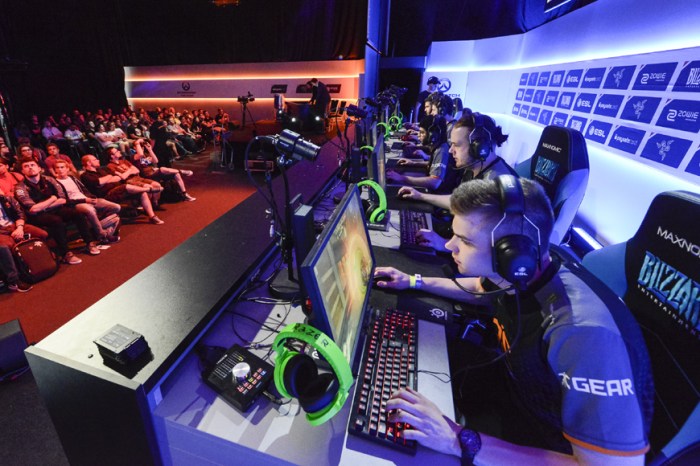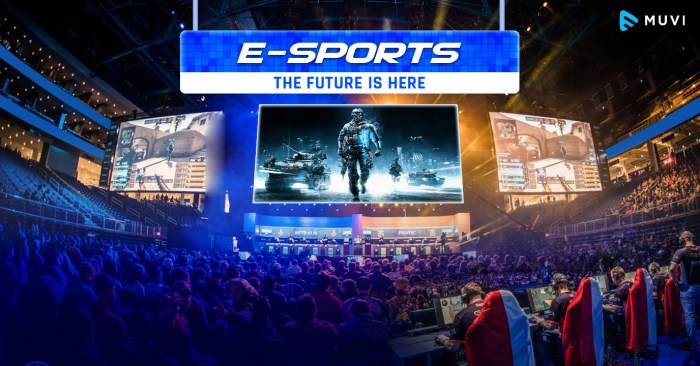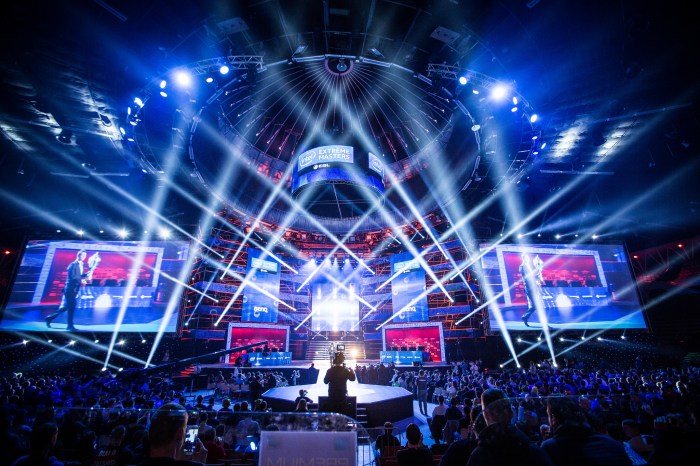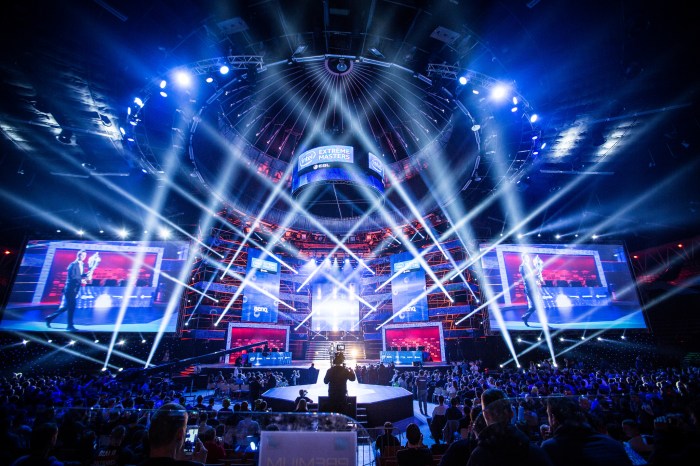Esports Community Events are exploding! This isn’t just about pro gamers; it’s about building passionate communities around competitive gaming. We’ll explore everything from tiny local tournaments to massive, sponsor-filled spectacles, looking at how they’re organized, funded, and what makes them tick. Think of it as a behind-the-scenes look at the heart of esports culture.
We’ll cover the different types of events, from grassroots gatherings to huge professional tournaments, examining the unique characteristics of each. We’ll also dive into community engagement strategies, successful event formats, the crucial role of sponsorships, and the lasting impact these events have on their communities and the esports world as a whole. Get ready to level up your understanding of esports events!
Community Engagement and Participation

A thriving esports community is the lifeblood of any successful event. Building a strong sense of community not only boosts attendance and viewership but also creates a loyal fanbase that will return for future events and actively promote them to others. Engaging the community effectively translates into a more vibrant, interactive, and ultimately more profitable event.Community engagement is crucial for the success of esports events because it fosters a sense of belonging and shared passion among players, viewers, and organizers.
This shared experience leads to increased loyalty, higher viewership numbers, and ultimately, more sponsorships and revenue. A strong community also provides valuable feedback that can be used to improve future events.
Successful Community Engagement Strategies
Successful community engagement hinges on creating multiple touchpoints for interaction. Past esports events have leveraged various strategies to achieve this. For example, the Evolution Championship Series (Evo) consistently fosters a strong sense of community through its extensive online presence and engaging social media campaigns. They actively respond to fan comments and questions, fostering a dialogue that makes fans feel heard and valued.
Another example is the League of Legends World Championship, which utilizes massive in-person events with interactive booths, meet-and-greets with players, and dedicated community spaces to encourage interaction among fans.
The Role of Social Media in Fostering Community Interaction
Social media platforms are indispensable for fostering community interaction during esports events. Platforms like Twitter, Twitch, Discord, and Instagram provide avenues for real-time engagement. Live tweeting during matches, running polls and Q&A sessions, and using relevant hashtags to consolidate conversations are effective tactics. Behind-the-scenes content, player interviews, and interactive games or challenges on these platforms can significantly boost engagement and generate buzz.
For instance, many esports organizations use Twitter polls to decide on things like future tournament skins or even team strategies, creating a sense of community ownership.
Innovative Ways to Encourage Audience Participation
Going beyond simply spectating, esports events can incorporate innovative methods to actively engage the audience. Interactive elements like live in-game polls influencing gameplay, prediction contests with prizes, and virtual meet-and-greets with players using platforms like Zoom or Discord enhance the viewer experience. Augmented reality (AR) filters or virtual merchandise can also create a more immersive and participatory experience for viewers at home.
For example, some events have incorporated AR filters that let viewers put on virtual team jerseys or hats, allowing for a fun, sharable experience.
Promotional Campaign for Increased Community Involvement, Esports Community Events
To boost community involvement in a hypothetical esports event, “Clash of Titans,” a multi-game tournament, we would launch a multi-pronged promotional campaign. This campaign would emphasize inclusivity and community building.First, we would launch a social media campaign using targeted ads and influencer marketing to reach potential attendees. We would create engaging content like short videos showcasing the event’s highlights and behind-the-scenes glimpses.
We would use interactive polls and contests on platforms like Twitter and Instagram to generate buzz and encourage participation. A dedicated Discord server would act as a central hub for community communication, providing a platform for discussions, announcements, and Q&A sessions with organizers and players.Second, we would offer incentives for community involvement, such as exclusive merchandise giveaways for active participants in online contests and challenges.
We would also organize pre-event online tournaments and workshops to encourage participation and build excitement. Finally, we would actively solicit feedback from the community throughout the event and use it to improve future events. This participatory approach would foster a sense of ownership and loyalty among participants, contributing to the long-term success of the “Clash of Titans” event.
Esports Event Formats and Structures: Esports Community Events

Planning a killer esports event hinges on choosing the right format and structure. The format dictates how the competition unfolds, while the structure determines how participants are matched and progress through the event. Getting these right is crucial for player engagement and overall event success.
Different formats cater to various community sizes and goals. Tournaments are the classic, competitive showdown, often focused on a single game or title. Leagues offer a longer-term, more structured approach, with teams competing over multiple weeks or months. Exhibitions, on the other hand, are more casual and showcase player skill or new game releases, often lacking the intense competitive pressure of tournaments or leagues.
Tournament Structures: Single-Elimination vs. Round-Robin
The choice between single-elimination and round-robin tournament structures significantly impacts the event’s flow and competitiveness. Single-elimination, as the name suggests, eliminates players after a single loss. This creates a high-stakes, fast-paced environment, but leaves less room for upsets or showcasing consistent performance. Round-robin, conversely, has each participant play every other participant. This provides a more comprehensive evaluation of player skill and allows for more matches, potentially increasing audience engagement, but it’s significantly longer and requires more resources.
Consider a hypothetical 8-team tournament. Single-elimination requires only 7 matches to crown a winner, while a round-robin format necessitates 28 matches (7 teams x 4 matches each). The time commitment and logistical requirements differ vastly.
Key Elements of a Successful Event Format
Several factors contribute to a successful esports event format. These elements must be carefully considered during the planning phase to ensure a smooth and engaging experience for both participants and spectators.
- Clear Rules and Regulations: Ambiguity breeds frustration. A well-defined rulebook is essential to prevent disputes and ensure fair play.
- Appropriate Prize Pool: The prize pool should align with the event’s scale and the community’s expectations. A larger prize pool often attracts more skilled players and viewers.
- Engaging Format: The chosen format should be exciting and easy to follow for both players and spectators. Consider incorporating elements like group stages or playoffs to maintain audience interest.
- Effective Communication: Keeping participants and spectators informed throughout the event is vital. Use multiple communication channels (e.g., social media, in-game announcements) to share updates and answer questions.
- Professional Production: High-quality streaming and commentary enhance the viewer experience and create a more professional image for the event.
Planning an Esports Tournament: A Step-by-Step Guide
Organizing a successful esports tournament involves a structured approach. Here’s a breakdown of the key stages:
- Define Goals and Scope: Determine the game, target audience, and desired scale of the tournament.
- Establish Budget and Resources: Secure funding and identify necessary resources (e.g., venue, equipment, staff).
- Develop Rules and Regulations: Create a comprehensive rulebook addressing all aspects of gameplay and conduct.
- Set Up Registration and Player Management: Implement a system for registering participants and managing their progress throughout the tournament.
- Schedule and Logistics: Plan the tournament schedule, considering match times, breaks, and any special events.
- Promote the Event: Use various marketing channels to attract participants and viewers.
- Execute the Tournament: Run the tournament according to the established schedule and rules.
- Post-Event Analysis: Evaluate the success of the event and identify areas for improvement in future tournaments.
Flowchart of a Major Esports Community Event
The following describes a typical flow for a large-scale event. Note that specific steps and their order might vary based on the event’s format and scale.
Imagine a flowchart. It starts with “Event Planning” branching into “Budgeting,” “Rule Creation,” “Marketing,” and “Venue Selection.” These all feed into “Registration and Player Selection.” This leads to “Tournament Execution,” which then branches into “Live Streaming,” “On-site Management,” and “Commentary.” “Tournament Execution” also leads to “Results and Awards,” which finally leads to “Post-Event Analysis.”
Impact and Legacy of Esports Community Events

Esports community events aren’t just about the games; they’re significant drivers of economic growth, social connection, and the overall evolution of the esports industry. These events leave a lasting mark on the communities that host them, fostering innovation and creating opportunities that extend far beyond the final match. Understanding this impact is crucial for both organizers and communities looking to leverage the power of esports.Esports community events generate substantial economic activity.
Economic Impact on Local Communities
Hosting an esports event brings a significant influx of cash into a local economy. Attendees spend money on hotels, restaurants, transportation, and local merchandise. This increased spending stimulates businesses, creates jobs (temporary and sometimes permanent), and generates tax revenue for the local government. For example, a major tournament held in a smaller city might see a noticeable increase in hotel occupancy rates, restaurant sales, and even demand for local transportation services.
The economic benefits are particularly pronounced when events attract attendees from outside the immediate area, bringing in new revenue streams. The size of the economic impact directly correlates with the scale of the event – larger events naturally generate greater economic activity. A well-organized event can leave a lasting positive financial impact on a community long after the final match concludes.
Social and Cultural Significance of Esports Events
Beyond the financial benefits, esports events play a crucial role in shaping local culture and fostering a sense of community. These events bring people together, creating a shared experience and a sense of belonging. They often highlight local talent, showcasing the skills and passion of local gamers. The social aspect extends beyond the attendees; successful events can raise the profile of the host city or region, attracting new residents and businesses.
Moreover, these events can help to normalize esports as a legitimate form of entertainment and competition, challenging stereotypes and fostering inclusivity. For instance, events that actively promote diversity and inclusion can help to create a more welcoming and representative esports community.
Long-Term Effects on Esports Ecosystem Growth
Successful esports community events act as catalysts for the growth of the entire esports ecosystem. They provide valuable experience for organizers, players, and sponsors, leading to improvements in event management, player development, and sponsorship strategies. The data and insights gathered from these events can inform future planning and contribute to the overall maturation of the industry. Moreover, successful events attract media attention and sponsorship, further boosting the visibility and legitimacy of esports.
This increased visibility can inspire new talent to enter the field and encourage investment in the industry. The long-term impact is a more robust and sustainable esports ecosystem.
Examples of Events with Lasting Positive Impact
Several esports events have demonstrated the potential for lasting positive impact. For example, the evolution of EVO (Evolution Championship Series), a fighting game tournament, illustrates how a consistently well-organized and engaging event can build a dedicated community and a global following. Its longevity and impact on the fighting game community are testaments to its positive influence. Similarly, many regional or city-specific events have fostered local esports scenes, creating opportunities for local players and businesses.
These smaller-scale events often serve as stepping stones for aspiring professional players and event organizers.
Measuring the Success and Impact of an Esports Event
To effectively measure the success and impact of an esports event, a multi-faceted approach is needed.
The following steps provide a comprehensive framework for evaluating the success of an esports event:
- Pre-event planning and target setting: Define clear, measurable objectives (e.g., attendance targets, media coverage, economic impact) before the event.
- Attendance and engagement metrics: Track ticket sales, online viewership, social media engagement, and on-site participation.
- Economic impact assessment: Conduct surveys and analyze spending data to quantify the economic benefits to the host community.
- Media coverage analysis: Monitor media mentions and social media sentiment to gauge the event’s reach and reputation.
- Post-event surveys: Gather feedback from attendees, sponsors, and local businesses to assess satisfaction and identify areas for improvement.
- Long-term follow-up: Track the long-term impact on the local esports community, including the growth of local teams and events.
- Qualitative data gathering: Collect feedback from attendees, staff, and sponsors to gauge the overall experience and satisfaction.
FAQ Summary
What’s the difference between a LAN party and an esports event?
A LAN party is primarily focused on casual gaming and socializing, while an esports event is structured around competitive gameplay, often with prizes and sponsorships.
How can I get involved in organizing an esports event?
Start small! Organize a local tournament with friends, then gradually build experience and connections within the community. Networking with other organizers and sponsors is key.
What are some common mistakes to avoid when planning an esports event?
Poor communication, inadequate budgeting, and neglecting community engagement are common pitfalls. Careful planning and attention to detail are crucial.
How do I find sponsors for my esports event?
Create a compelling sponsorship proposal highlighting the potential benefits for sponsors, such as brand exposure and engagement with a targeted audience. Reach out to companies aligned with gaming and esports.
